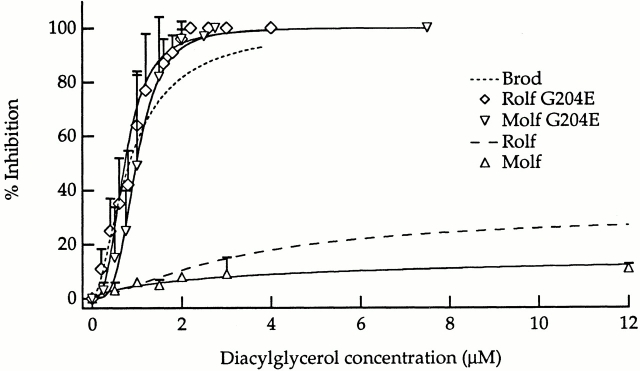Figure 4.
DAG completely suppressed saturating cGMP-activated currents of Molf G204E and Rolf G204E CNG channels, but only partially inhibited the corresponding wild-type channels at saturating agonist concentrations. Brod and Rolf data from the companion article (Crary et al. 2000, in this issue) are shown for comparison. Saturating cGMP concentrations were 2 mM for Brod channels and 100 μM for all Molf and Rolf channels. Averaged data obtained at saturating cGMP were fit with the Hill equation, IN/INmax = [DAG]n/(IC50 n + [DAG]n) where IN is the percent inhibition, INmax is maximal inhibition, IC50 is the concentration of DAG required to achieve half-maximal inhibition, and n is the Hill coefficient. As for Fig. 2, the relation was scaled to reflect the measured maximal IN/INmax. For the Brod, Molf G204E, and Rolf G204E channels, the maximum inhibition was 100%. For Brod (11 patches), IC50 = 0.83 μM, and n = 1.7; for Molf G204E (12 patches), IC50 = 0.99 μM, and n = 3.6; and for Rolf G204E (5 patches), IC50 = 0.73 μM and n = 2.8. For the wild-type olfactory channels, inhibition is only partial. For Rolf (13 patches), INmax = 31%, IC50 = 3.24 μM (denoting 15.5% inhibition), and n = 1.4; and for Molf (5 patches), INmax = 17%, IC50 = 3.50 μM (denoting 8.5% inhibition), and n = 0.8. Hill fits of Brod and Rolf channels are designated by dashed lines. Error bars indicate SDs.

